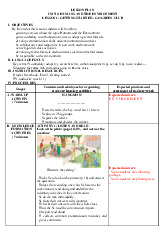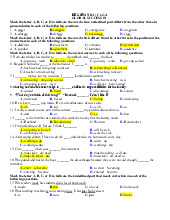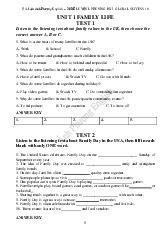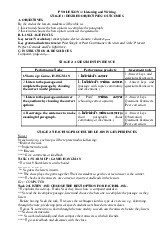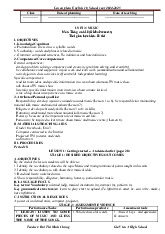












Preview text:
Date of planning: …/… / 2022
Date of teaching: …/… / 2022 WEEK: 14 Period 40 UNIT 5: INVENTIONS Lesson 4: Speaking
I. OBJECTIVES:* By the end of this unit, students will be able to gain the following things: 1. Knowledge:
- Talk about inventions and how they are used. 2. Competence:
- Develop communication skills and creativity.
- Be collaborative and supportive in pair work and team work. - Develop presentation skill.
- Actively join in class activities. 3. Qualities:.
- Develop flexibility and creativity in learning.
- Be responsible for studying, using educational apps. II. TEACHING AIDS:
- Teacher: Grade 10 text book, laptop, projector / TV/ pictures and cards......
- Students: Text books, studying equipment….
- Computer connected to the Internet. - Sach mem.vn III. PROCEDURE:
Notes: In each activity, each step will be represented as following: * Deliver the task. * Implement the task. * Discuss.
* Give comments or feedback.
1. WARM UP & INTRODUCTION ( 3’- 5’) Aims:
- To introduce the topic of speaking.
- To enhance students’ skills of cooperating with teammates.
* Content: To have some warm-up activities to create a friendly and relaxed atmosphere to inspire Ss to
warm up to the subject and new lesson.
* Outcome: Lead to the subject and new lesson.
* Organisation: Teacher’s instructions …
Teacher’s Student’s activities Content
+ Greeting + Asking question: Game: Guessing
* Teacher writes names of 5 inventions (the Rules
internet, e-readers, robots, 3D printing, driverless
* Teacher writes names of 5 inventions (the
cars) on cards and places them on a table face
internet, e-readers, robots, 3D printing, driverless
down. Teacher has Ss take turns picking a card and
cars) on cards and places them on a table face
explaining it to the class without showing the word. down. Teacher has Ss take turns picking a card
The rest of the class guess its name.
and explaining it to the class without showing the
Example: This invention is a device which helps us
word. The rest of the class guess its name.
to communicate over long distances. What is it?
Example: This invention is a device which helps (answer: telephone)
us to communicate over long distances. What is it?
** Ss take turns picking a card and give short (answer: telephone) descriptions of inventions.
Example: This invention is a device which helps
*** Students guess the names of the inventions.
us to communicate over long distances. What is it?
**** Teacher check the answers. (answer: telephone)
2. PRESENTATION/ NEW LESSON ( 12’- 15’)
Aims: To equip Ss with useful expressions before speaking activities.
* Content: useful expressions before speaking activities.
* Outcome: students know how to use useful expressions before speaking activities. * Organisation:
Teacher’s Student’s activities Content
* Teacher elicits some useful expressions to talk
about the uses of inventions and asks Ss to give Useful expressions examples. Functions Useful expressions
** Ss listen to T and give examples
*** Some students share the answers with the Uses of - … help(s)/ allow(s) us to whole class. inventions do st.
**** Teacher gives feedback and checks if Ss have Example: The internet
come up with any other phrases and write their helps us to communicate ideas on the board. over long distances. - We/ People (can) use the internet to communicate over long distances. - … is/ are used for st/ doing st. Example: The internet is used for communication/ communicating over long distances. SPEAKING 1.
E-readers /iː-ˈriːdəz/ (n.phr): thiết bị đọc sách điện tử 2.
3D printing /θriːdiː ˈprɪntɪŋ/ (n.phr): in 3D 3.
driverless car /ˈdraɪvləs kɑː/ (n.phr): xe không người lái 4.
distance /ˈdɪstəns/ (n): khoảng cách 5.
be used for /biː juːzd fɔː/ (v.phr): được sử dụng 6.
development /dɪˈveləpmənt/ (n): sự phát triển 7.
important /ɪmˈpɔːtnt/ (adj): quan trọng 3. PRACTICE ( 15’)
Aim: To help Ss practice useful expressions and structure their presentation.
* Content: Talk about the uses of these inventions. Use the expressions below to help you (p.56).
* Outcome:.Ss practice useful expressions and structure their presentation * Organisation :
Teacher’s Student’s activities Content Work in pairs.
* Teacher asks Ss to skim through the list of Talk about the uses of these inventions. Use the
inventions and their uses. Then teacher asks Ss to expressions below to help you
work in pairs, talk about the uses of these Cấu trúc:
inventions, using the expressions in the pre- S + help(s)/ allow(s) us to do sth: ... giúp/ cho speaking part.
phép chúng ta làm việc gì
** Students work in pairs and do as required.
We/ People (can) use sth to do/ for sth: Chúng ta/
Teacher walks round the class and offer help and Mọi người có thể sử dụng... để...
makes sure Ss swap their roles and each has a S + is/ are used for sth/ doing sth: ... được sử dụng
chance to ask and answer the questions. cho việc...
*** Some students share the answer with the whole 1. The Internet allows us to communicate over class. long distances.
**** Teacher give feedback, checking Ss’ ideas, 2. People use e-readers to store and read text.
pronunciation, and language used.
3. Robots are used for doing difficult or dangerous tasks effectively.
4. 3D printing helps us to make three dimensional objects.
5. We use driverless cars to travel around without a person in control.
Work in groups. Talk more about one of the
* Teacher puts Ss into groups and has them choose inventions in activity 1. Use the outline below to
one of the inventions in activity 1 to talk more help you prepare a group presentation. about it.
** Ss study the suggested outline.
*** Ss discuss their inventions in groups, and take
notes of their ideas on pieces of paper which can be used for their presentation.
**** Teacher walks round the class and offers help
with language or organisation of the presentations.
Teacher makes sure that each student in the group
contributes to the discussion and has part of the
presentation assigned to him/ her.
Talking about an invention (Introduction: What is it? ( Development:
- What are its uses? What are some examples?
- Have you ever used it? When/ Where/ How (often) do you use it? Conclusion:
- How important is it in our daily life
- Do you like using it? - The Internet is used to
communicate over long distances. People access
to the Internet and use many websites to interact
with others like Facebook, Instagram, Skype, …
- I use the Internet every day. I use it at school and
at home. The Internet helps me manage difficult
task and assist me to find solutions quickly. At
home, it provides me entertainment with online music, games and movies, … Conclusion:
I like using the Internet. I think Internet is very
important in our daily life. It makes our lives easier and more convenient.
4. PRODUCTION/ FURTHER PRACTICE ( 8’)
Aim: To help students enhance presentation skill
* Content: Present your ideas to the whole class. Then vote for the most interesting group presentation.
* Outcome: students’ talks * Organisation :
Teacher’s Student’s activities Content
* Teacher asks Ss to remain in the groups they
formed in activity 2. Explain that now groups will
Present your ideas to the whole class. Then vote
have three minutes to present their ideas to the
for the most interesting group presentation. class.
ello everyone. Today I am presenting a very useful
- Teacher encourages the rest of the class to listen
invention. It is the Internet. The Internet is used to
and take notes of the points they like. Alternatively, communicate over long distances. People access
teacher has Ss give each group a mark out of 6
to the Internet and use many websites to interact
based on some simple criteria of assessment (such
with others like Facebook, Instagram, Skype, … I
as content, language, and delivery. Each worth 2
use the Internet every day. I use it at school and at points).
home. The Internet helps me manage difficult task
** Students work in groups and decide how they
and assist me to find solutions quickly. At home, it
will present the information, who is going to
provides me entertainment with online music,
introduce and end the presentation, and how to
games and movies… I like using the Internet. I
divide the tasks among group members.
think Internet is very important in our daily life. It
*** Groups present their ideas in front of class.
makes our lives easier and more convenient.
**** Teacher asks the rest of the class to give
feedback after each presentation. Teacher also lets
Ss reflect on their performance. Then teacher
praises groups for their efforts and makes
suggestions for better organisation and presentation of Ss’ ideas.
5. WRAP-UP & HOME WORK (2’)
- Some useful expressions about uses of inventions.
- Speaking about inventions and how they are used. Homework:
- Prepare for the next lesson: Unit 5: Listening. - Exercises in the workbook.
=========================
Date of planning: …/… / 2022
Date of teaching: …/… / 2022 WEEK: 14 Period 41 UNIT 5: INVENTIONS
Lesson 5: Listening – Robo Vacuum
I. OBJECTIVES: * By the end of this unit, students will be able to gain the following things: 1. Knowledge: -
Use the lexical items related to the topic Inventions. -
Listen for specific information about how to use an invention. 2. Competence:
- Develop communication skills and creativity.
- Be collaborative and supportive in pair work and team work.
- Actively join in class activities. 3. Qualities:.
- Develop awareness and flexibility in using an invention. II. TEACHING AIDS:
- Grade 10 textbook, Unit 5, Listening
- Computer connected to the Internet
- Projector/ TV/ pictures and cards - sachmem.vn III. PROCEDURE:
Notes: In each activity, each step will be represented as following: * Deliver the task. * Implement the task. * Discuss.
* Give comments or feedback.
1. WARM UP & INTRODUCTION ( 3’- 5’) Aims:
- To introduce the topic of reading.
- To enhance students’ skills of guessing.
* Content: To have some warm-up activities to create a friendly and relaxed atmosphere to inspire Ss to
warm up to the subject and new lesson.
* Outcome: Lead to the subject and new lesson.
* Organisation: Teacher’s instructions …
Teacher’s Student’s activities Content
+ Greeting + Asking question: * Guessing game
* T shows 3 clues about the targeted word in turn
It is a household appliance.
and asks Ss to guess the word. It has wheels.
It is a household appliance.
It sucks up dirt and dust. It has wheels. Answer:
It sucks up dirt and dust. Robo vacuum
** - Ss guess the words basing on clues given by the T.
*** If Ss can’t get the word with the 1st clue, the T gives them the 2nd clue.
If Ss can’t get the word with the 2nd clue, the T gives them the 3rd clue.
**** T confirms the answers and leads in the new lesson.
2. PRESENTATION/ NEW LESSON ( 12’- 15’)
Aims: To set the context of the listening text and activate Ss’ prior knowledge. * Content: * Outcome: * Organisation:
Teacher’s Student’s activities Content
* T asks Ss to look at the explanation and the Vocabulary pre-teach
photos to guess the meaning of new words.
1. button (n) /ˈbʌtn/: cái nút
** Ss say the Vietnamese meaning of the word.
2. charge (v) /tʃɑːdʒ/: nạp, sạc (điện)
*** Other Ss correct if the previous answers are
3. stain (n) /steɪn/: vết bẩn incorrect.
**** T shows the Vietnamese meaning, says the
words aloud and asks Ss to repeat them.
Complete the sentences with the words in the
Complete the sentences with the words in the box. (p.57). box. (p.57).
1. Press the _________ to start the device.
* T asks Ss to complete the sentences with the
2. There is a dirty _________ on your words in the box.
smartphone. Wipe it away.
** Ss read and complete the sentences with the
3. You need to _________ your mobile phone. words in the box .
The battery is very low.
*** Ss share the answers with the whole class. Answers:
**** T checks answers as a class. 1. button 2. stain 3. charge 3. PRACTICE ( 15’)
Aim: To help Ss practise listening for key words.
To help Ss practise listening for instructions * Content: * Outcome:. * Organisation :
Teacher’s Student’s activities Content
Listen to a conversation about RoboVacuum.
* T tells Ss that they are going to listen to a Fill in each gap in the diagram below with one
conversation about a robot vacuum cleaner, called word. (p.57.)
RoboVacuum, between a woman and a salesman.
While listening, Ss should fill in the gaps in the Answers: diagram.
1. room 2. stains 3. stop
- T asks Ss to study the diagram first. e.g. T has Ss
look at the first item and asks them to predict the
kind of information needed and if it is a noun, a verb or an adjective …
** Ss listen and fill in the gaps in the diagram with one word.
*** Ss compare their answers in pairs.
**** T checks answers by playing the recording
again and pausing after each answer.
* T tells Ss that they are going to listen to the Listen again. Put a tick next to the correct way
conversation again. While listening, they should and a cross next to the wrong way to use
put a tick or a cross next to each picture that shows RoboVacuum. (p.57).
the right or wrong way of using RoboVacuum.
** T put Ss in pairs to study the pictures first and Key
describe what they can see, e.g. RoboVacuum is on
a puddle of water. It is also next to an electric
socket. – T encourages them to guess if that is the
right or the wrong way to use RoboVacuum.
- Ss listen, put a tick or a cross next to each picture
that shows the right or wrong way of using RoboVacuum.
*** Ss compare their answers in pairs.
**** T checks answers by playing the recording
again, pausing at the places where they can hear the correct information.
4. PRODUCTION/ FURTHER PRACTICE ( 8’)
Aim: To give Ss an opportunity to personalise the language and ideas from the listening in a speaking task.
* Content: What other buttons do you want Robo Vacuum to have? Add them to the picture below and tell your friends about them
* Outcome: students’s talks * Organisation :
Teacher’s Student’s activities Content
*T asks Ss to add to the picture other buttons that
What other buttons do you want Robo Vacuum
they want Robo Vacuum to have.
to have? Add them to the picture below and tell
** T models the task by drawing a picture of your friends about them. (p.57).
RoboVacuum and adding a timing button. T labels I want my Robo Vacuum to have a Timer button
it and reads the example to illustrate how it will be on the top. First, you press it. Then, you set the
used: I want my Robo Vacuum to have a Timer time by pressing the minutes and seconds buttons
button on the top. First, you press it. Then, you set on the right.
the time by pressing the minutes and seconds buttons on the right.
- Ss work individually to personalise their Robo
Vacuum by drawing and labelling their buttons.
- T walks round the class and offers help with the vocabulary.
*** T puts Ss in groups to show their drawings to
each other and share their ideas.
**** T invites some Ss to present their improved
RoboVacuum in front of the class. T praises for
interesting ideas and delivery.
5. WRAP-UP & HOME WORK (2’) -
Some lexical items related to the topic Inventions -
Listen for specific information about Robo vacuum. Homework:
- Prepare for the next lesson: Unit 5: Writing - Exercises in the workbook
=========================
Date of planning: …/… / 2022
Date of teaching: …/… / 2022 WEEK: 14 Period 42 UNIT 5: INVENTIONS
Lesson 6: Writing _ Writing about the benefits of an invention
I. OBJECTIVES:* By the end of this unit, students will be able to gain the following things: 1. Knowledge: -
Use the lexical items related to the topic Inventions. -
Write about the benefits of an invention. 2. Competence:
- Develop communication skills and creativity.
- Be collaborative and supportive in pair work and team work.
- Actively join in class activities. 3. Qualities:
- Develop flexibility and creativity in learning. - Develop self-study skills. II. TEACHING AIDS:
- Grade 10 textbook, Unit 5, Writing
- Computer connected to the Internet
- Projector/ TV/ pictures and cards - sachmem.vn III. PROCEDURE:
Notes: In each activity, each step will be represented as following: * Deliver the task. * Implement the task. * Discuss.
* Give comments or feedback.
1. WARM UP & INTRODUCTION ( 3’- 5’) Aims: -
To introduce the topic of writing.
* Content: To have some warm-up activities to create a friendly and relaxed atmosphere to inspire Ss to
warm up to the subject and new lesson.
* Outcome: Lead to the subject and new lesson.
* Organisation: Teacher’s instructions …
Teacher’s Student’s activities Content
+ Greeting + Asking question: Hot seat
* T divides the class into different groups and
shows pictures about different types of inventions Answer: on slides. 1. Electric light
** Representative of each group sits on a chair, 2. Airplane facing the class. 3. Automobile
*** Others from each group look at the picture
shown on slide and describe the picture/ give any hints about the picture.
**** Representative of each group says out loud the word.
The group with the largest number of correct answers is the winner.
2. PRESENTATION/ NEW LESSON ( 12’- 15’)
Aims: To provide Ss chances to list some benefits or uses of their invention
* Content: Choose an invention in this unit. Draw a diagram to show how it is used. Then work in
groups to guess one another's inventions * Outcome: answers * Organisation:
Teacher’s Student’s activities Content 1
1: Choose an invention in this unit. Draw a
* T asks each student to choose an invention from
diagram to show how it is used. Then work in
the unit. Ask them to keep it secret. Ask them to
groups to guess one another's inventions.
draw a diagram in their notebooks or on a piece of (p.58).
paper, listing some benefits or uses of their invention. E.g:
** T puts Ss into groups of four or five, and asks
them to swap their diagrams with other Ss in the group.
- Ss take turns reading the diagrams and guessing the inventions.
*** Ss work in groups, take turns reading the
diagrams and guessing the inventions
**** T checks answers as a class.
Answer: It's Artificial Intelligence
- At work: plan holidays for customer, answer questions, etc
- At home: clean the house, etc.
- In transport: find the best routes, etc. The Internet:
- communicate over long distances (- study and
work online (- find solutions for every question
* T asks Ss to study the useful expressions in the 2: Rewrite the second sentence so that it has a box
similar meaning to the first. Use the
expressions and the prompts below to help you.
** T focuses Ss’ attention on the sentences and (p.58)
check comprehension. Ask Ss to rewrite them,
using the suggested words and the structures in the box.
*** Ss work individually, rewriting the sentences.
- T walks round the class to offer help if necessary.
Use coloured chalk to underline the structures in the answers.
**** Teacher checks answers as a class. Answers:
1. Helping drivers to find the best routes is one of
the benefits of AI in transport.
2. Vacuum cleaners are useful for cleaning / in
cleaning the house quickly.
3. Smartphones help us to learn languages.
4. Telephones are used to communicate / for
communication / for communicating over long distances. 3. PRACTICE ( 15’)
Aim: To help Ss practise developing ideas and writing a paragraph.
* Content: Write a paragraph (120 - 150 words) to describe two or three benefits of the invention you
chose in 1. Use the outline below to help you
* Outcome: Ss practise developing ideas and writing a paragraph * Organisation:
Teacher’s Student’s activities Content
* T tells Ss that they are going to write a paragraph 3: Write a paragraph (120 - 150 words) to
of 120 - 150 words about the benefits of an describe two or three benefits of the invention
invention of their choice.
you chose in 1. Use the outline below to help
- T asks them to study the suggested outline. you. (p.58.)
- T reminds them to use the structures they have practised in activity 2 Sample answer:
** Ss work individually to write a draft.
Electricity is one of the great inventions of the
*** Ss check their draft for the first time.
past, because it has brought many benefits for
**** T walks round the class to offer help if people. First, electricity can be used to light our necessary.
houses and streets. Without it, the world will be .
dark and dangerous. Second, electricity is also
useful in heating. For example, in cold areas,
electric heaters can keep us warm and healthy in
long winters. Finally, the most important use of
electricity is to run machines. Without electricity,
factories, schools and hospitals cannot run
normally. Everyone and everything will stop
working. Other inventions, such as TVs,
computers and robots will become useless without
electricity. In conclusion, electricity plays a very
important part in our life today and we cannot live without it
4. PRODUCTION/ FURTHER PRACTICE ( 8’)
Aim: To do a cross-check and final check on students’ writing.
* Content: swap their paragraphs with a partner and comment on each other’s
* Outcome: students’ writings * Organisation:
Teacher’s Student’s activities Content
* T has Ss swap their paragraphs with a partner and comment on each other’s
The Internet is one of the most useful inventions
ideas, vocabulary and grammar.
in the 21st century. Firstly, the Internet allows us
** Ss work in pairs and swap their 1st drafts for
to communicate for long distances. For example, peer review.
we can use a mobile phone connected with the
*** T then gives feedback on one writing as a Internet to make a call, text messages with friends model.
from all over the world. Secondly, the Internet is
****T collects Ss’ writings to mark and provide very useful for us to study and work online. We
written feedback in the next lesson.
can join many online classes to study after school
or work from home with apps using the Internet.
Finally, the Internet is used to search for all the
questions. The Internet can quickly come up with
a dozens of answers which is contributed by many
users on it. In short, the Internet bring us many
benefits so people should try it soon.
5. WRAP-UP & HOME WORK (2’) -
Some lexical items related to the topic Inventions
Write about the benefits of an invention. Homework:
- Rewrite the paragraph in the notebooks.
- Prepare for the next lesson: Unit 5: Communication and culture/ CLIL. - Exercises in the workbook
=========================
